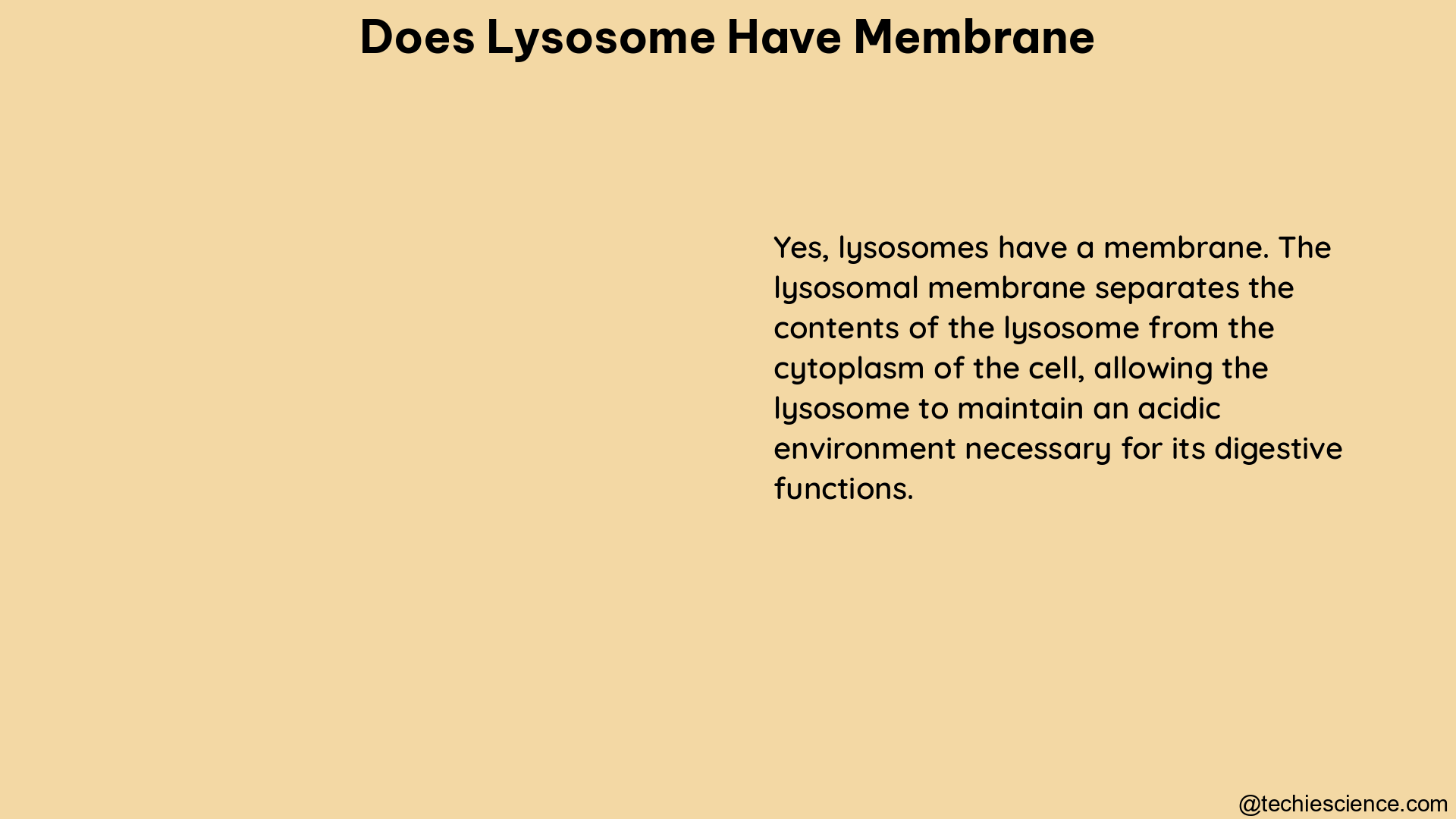Lysosomes are specialized organelles found in the cytoplasm of eukaryotic cells, and they are known for their role in the degradation and recycling of cellular components. One of the defining features of lysosomes is the presence of a membrane that surrounds them, which is crucial for their function and maintenance.
The Lysosomal Membrane: Structure and Composition
The lysosomal membrane is a single-bilayer lipid membrane that serves as a barrier between the acidic interior of the lysosome and the neutral cytosol. This membrane is composed of a variety of lipids, including phospholipids, glycolipids, and cholesterol, which provide the necessary fluidity and permeability for the organelle’s function.
The lysosomal membrane also contains a diverse array of integral and peripheral membrane proteins, which play crucial roles in the following processes:
-
Maintaining the Acidic Environment: The lysosomal membrane contains proton pumps and ion channels that actively transport protons (H+) into the lysosomal lumen, creating an acidic environment with a pH ranging from 4.5 to 5.0. This acidic environment is essential for the optimal activity of the hydrolytic enzymes within the lysosome.
-
Regulating Molecular Transport: The lysosomal membrane is selectively permeable, allowing the controlled movement of molecules, such as nutrients, waste products, and hydrolytic enzymes, in and out of the lysosome. This is achieved through the presence of various transport proteins, including channels, carriers, and pumps.
-
Signaling and Membrane Dynamics: The lysosomal membrane also plays a role in cellular signaling pathways and membrane dynamics. It can interact with other organelles, such as the endoplasmic reticulum and the Golgi apparatus, to facilitate the delivery of materials and the exchange of information.
Lysosomal Membrane Permeabilization (LMP)

The integrity of the lysosomal membrane is crucial for the proper functioning of lysosomes. Disruption of the lysosomal membrane, a process known as lysosomal membrane permeabilization (LMP), can have severe consequences for the cell.
LMP can occur due to various factors, such as oxidative stress, exposure to certain toxins, or the accumulation of specific compounds within the lysosome. When the lysosomal membrane is compromised, the hydrolytic enzymes within the lysosome can be released into the cytosol, leading to the activation of cell death pathways and ultimately, cell death.
Quantifying Lysosomal Membrane Permeabilization
Researchers have developed several methods to quantify the extent of LMP, which can provide valuable insights into the cellular processes and pathways involved. Some of the commonly used techniques include:
-
Measurement of Lysosomal Hydrolase Release: This method involves measuring the activity of lysosomal hydrolases, such as cathepsins, in the cytosol. Upon LMP, these enzymes are released from the lysosome and can be detected using fluorogenic substrates.
-
Fluorescent Dextran Release Assay: In this assay, cells are loaded with fluorescent dextran, a large molecule that is normally retained within the lysosome. LMP leads to the release of dextran into the cytosol, which can be monitored by time-lapse imaging and used to determine the size of the membrane pores.
-
Immunocytochemistry for Cathepsin Detection: Immunocytochemistry can be used to visualize the localization of cathepsins within the cell. In healthy cells, cathepsins are confined to the lysosomal lumen, but upon LMP, they are released into the cytosol, resulting in a diffuse staining pattern.
-
Galectin Translocation Assay: Galectins are cytosolic proteins that translocate to damaged lysosomes upon LMP. The detection of galectin translocation by immunocytochemistry can serve as a marker for LMP.
These quantitative methods provide valuable insights into the dynamics and extent of lysosomal membrane permeabilization, which is crucial for understanding cellular processes and the role of lysosomes in various pathological conditions.
Conclusion
In summary, lysosomes are indeed surrounded by a membrane, which is a crucial component for their proper function. The lysosomal membrane maintains the acidic environment within the lysosome, regulates the movement of molecules, and plays a role in cellular signaling and membrane dynamics. Disruption of the lysosomal membrane, known as lysosomal membrane permeabilization, can have severe consequences for the cell and is an important area of study in cell biology and disease research.
References:
- Methods for the functional quantification of lysosomal membrane permeabilization: a hallmark of lysosomal cell death. https://www.ncbi.nlm.nih.gov/pmc/articles/PMC7611294/
- Signals for the lysosome: a control center for cellular clearance and energy metabolism. https://www.ncbi.nlm.nih.gov/pmc/articles/PMC4387238/
- Methods for the quantification of lysosomal membrane permeabilization. https://www.sciencedirect.com/science/article/abs/pii/S0091679X14000338

Hello, I am Bhairavi Rathod, I have completed my Master’s in Biotechnology and qualified ICAR NET 2021 in Agricultural Biotechnology. My area of specialization is Integrated Biotechnology. I have the experience to teach and write very complex things in a simple way for learners.